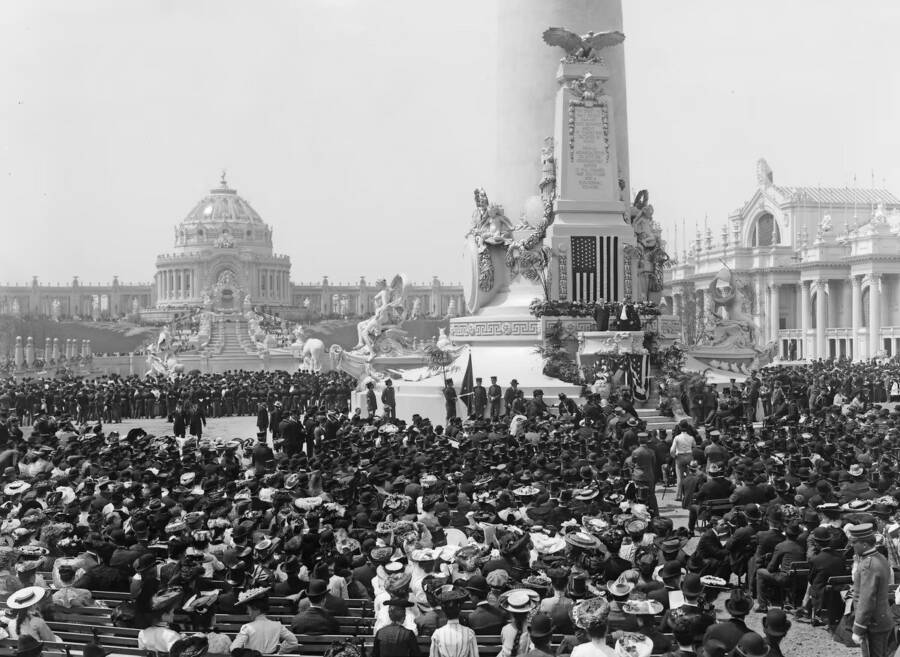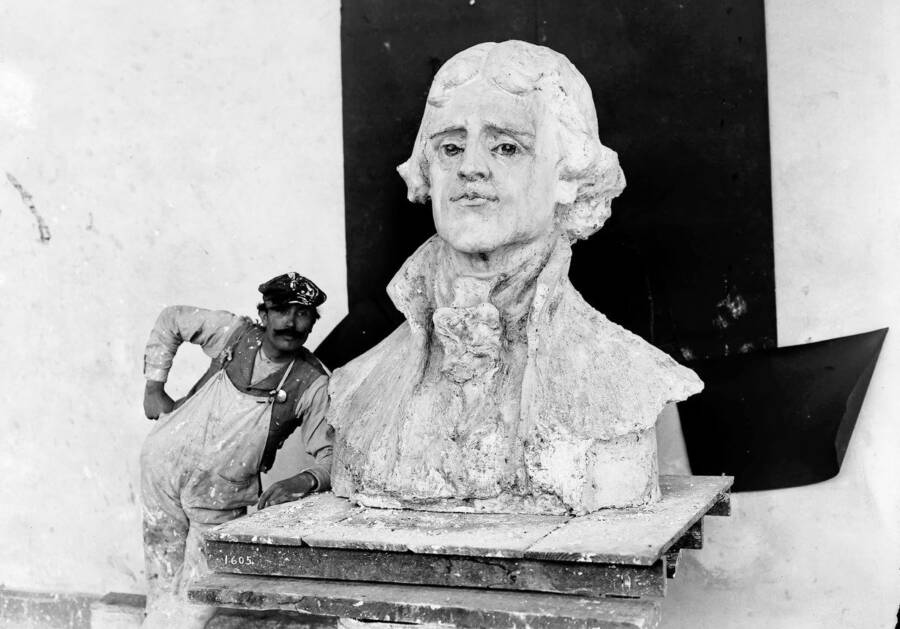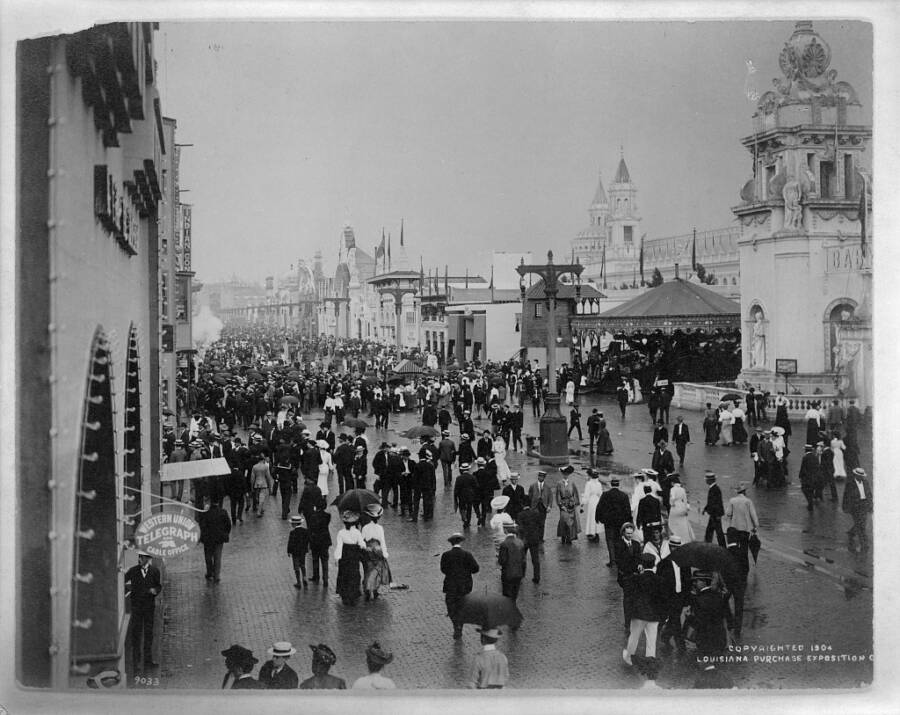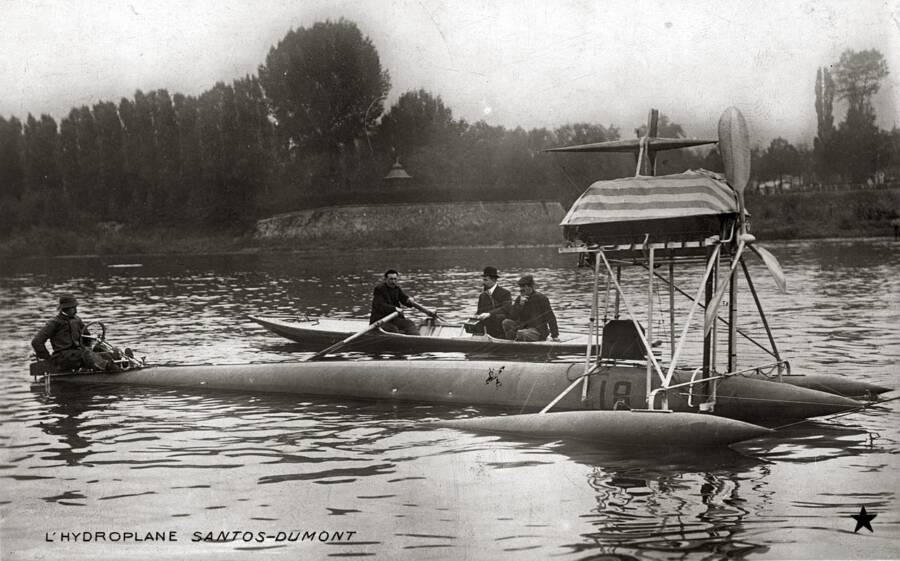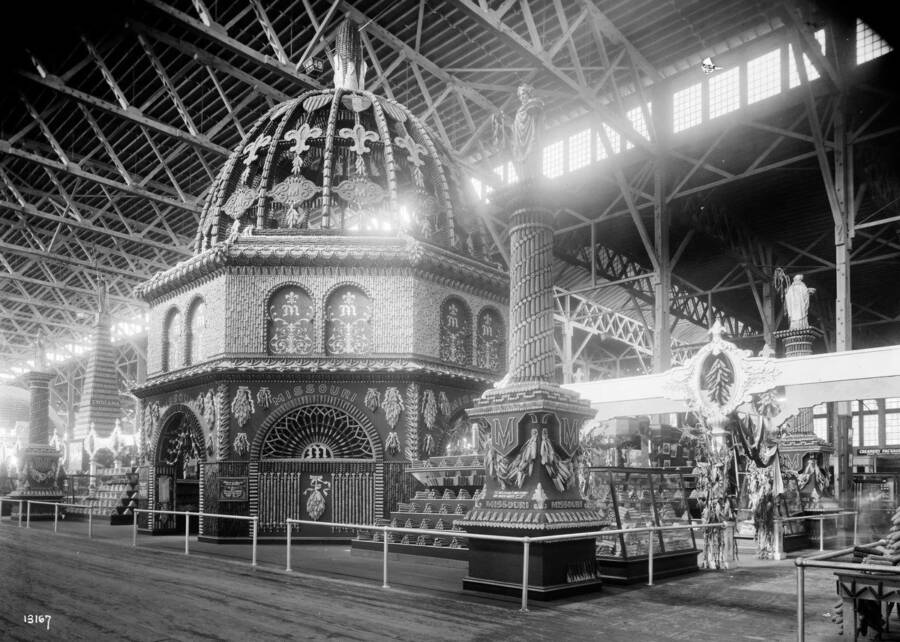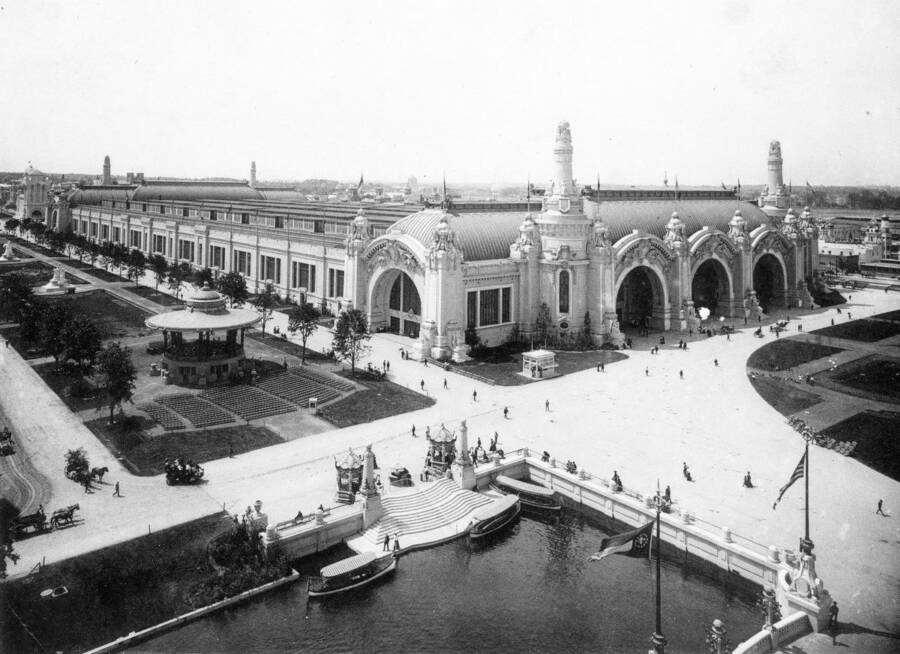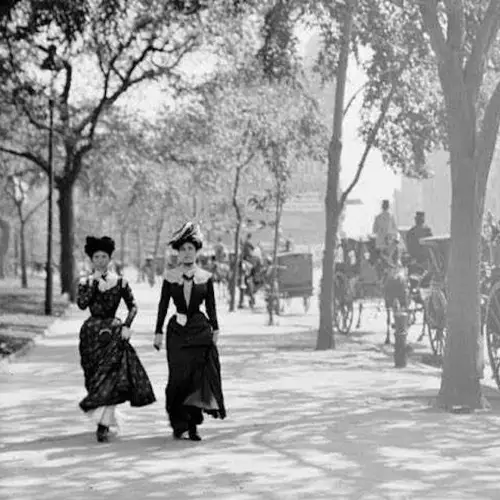Held for the centennial celebration of the Louisiana Purchase, the 1904 St. Louis World's Fair drew 20 million visitors and is remembered for introducing the American public to the ice cream cone — and for its "human zoos."
In 1904, the world came to St. Louis. The 1904 St. Louis World’s Fair — also called the Louisiana Purchase Exposition — ran for eight months, hosted an estimated 20 million visitors, and displayed exhibits from 60 foreign countries as well as 43 of the 45 American states.
There, visitors could enjoy the incredible sights, sounds, inventions, events, and new foods on display. They could explore the fair’s 1,500 buildings — arrayed over 1,200 acres in Forest Park — taste Dr. Pepper, marvel at new inventions like the electric typewriter, and even attend the 1904 Olympic Games.
But the St. Louis World’s Fair had a dark side, too. Fair organizers infamously brought people from foreign lands, including the Philippines, and put them on display for gawking attendees. The fair also hosted notorious Anthropology Days, in which “savages” competed before white audiences.
Discover the 1904 St. Louis World’s Fair in the gallery below, and read on to learn about the highs and lows of this momentous historic event.
Building The 1904 St. Louis World's Fair
In August 1901, President William McKinley proclaimed that the next World's Fair would be held in St. Louis, Missouri. Dubbed the Louisiana Purchase Exposition, the fair — originally set to take place in 1903 — would celebrate the centennial of the Louisiana Purchase, which added 530,000,000 acres of territory to the young United States in 1803.
"[I]n the name of the Government and of the people of the United States, I do hereby invite all the nations of the earth to take part in the commemoration of the purchase of the Louisiana Territory," McKinley declared.

St. Louis Public Library Digital CollectionsConstruction of the Palace of Machinery during the summer of 1903.
Just a month later, McKinley was felled by an assassin's bullet. But plans for the grand Louisiana Purchase Exposition went on. As the Missouri Historical Society writes, more than 10,000 laborers toiled to transform "1,200 acres of thickets and swamps" in St. Louis into a "grand landscape."
Though the fair was delayed by a year — the Minneapolis Journal reported that foreign nations needed more time to prepare their exhibits — the St. Louis World's Fair opened to great fanfare on April 30, 1904.
"Open ye gates! Swing wide ye portals!" Louisiana Purchase Exposition Company President David R. Francis declared.
With that, the opening day crowd of 200,000 people streamed into the fairgrounds, where they would find 1,500 elaborate buildings, exciting inventions to marvel at, new foods to taste, and much more.
Inside The Louisiana Purchase Exposition
The St. Louis World's Fair held adventure around every corner. Visitors could wander the mile-long boulevard called "The Pike" and take in the sights and sounds — contortionists, exotic animals, and new foods — all of it dazzling thanks to the electric lights which blazed from every major building.

Library of CongressAn illustration of the 1904 St. Louis World's Fair from above. Some 20 million people would visit the fair.
Visitors marveled at exciting new inventions like private automobiles, the X-ray machine, "flying machines," and household items like coffeemakers and dishwashers. Many of them would taste new foods for the first time, like the ice cream cone, peanut butter, and Dr. Pepper soda. (As Washington University in St. Louis notes, it was the first time that many Americans experienced these foods, though they were not invented at the fair itself.)
Fairgoers also encountered a number of incredible sights, including huge redwood trees felled in California, elephants made of almonds — as well as real elephants sliding down chutes — exotic dancers, dinosaur fossils, and more. Americans recognized some of the displays, like the Liberty Bell or Abraham Lincoln's childhood cabin, but were awestruck by the sight of camels wandering the grounds.
They were also awestruck by the luminaries present at the Louisiana Purchase Exposition. The fair was attended by President Theodore Roosevelt, the Secretary of War — and future president — William Howard Taft, the Apache leader Geronimo, deaf-blind activist Helen Keller, distiller Jack Daniel, poet T.S. Eliot, and many others.
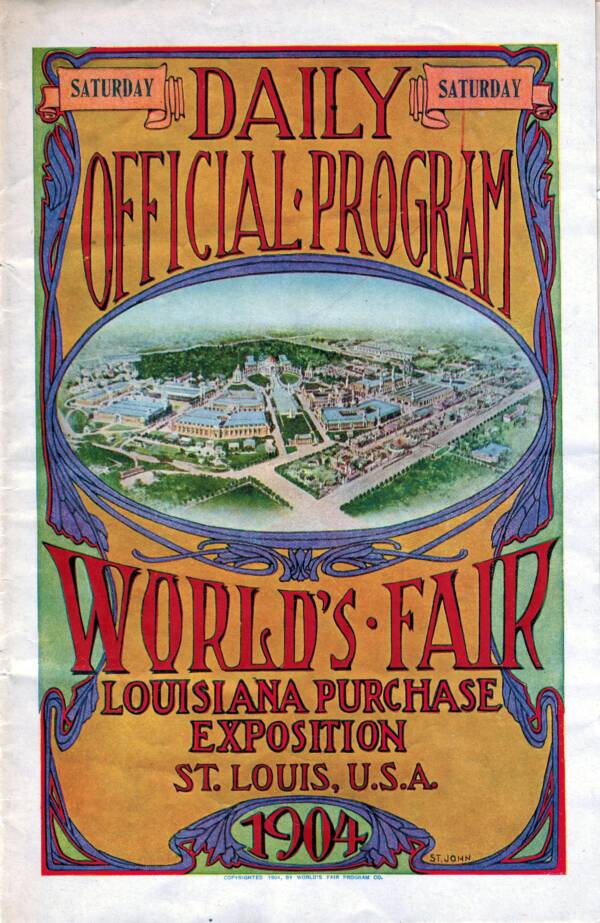
National Parks ServiceAn official program from the 1904 St. Louis World's Fair.
What's more, visitors also had the chance to witness the 1904 Olympic Games — and the calamitous 1904 Olympic marathon — as well as exciting reenactments of events like the Boer War.
All the sights of the fair — which drew an estimated 20 million people by the time it closed in December — were best viewed from the Observation Wheel, which offered a bird's-eye view from 264 feet in the air.
But this view could not capture the fair's deep-seated racism.
Racism On Display At The World's Fair
Today, the 1904 St. Louis World's Fair is viewed with pride in Missouri. But the fair was also the site of some deeply racist exhibits and events.
Alongside the hot dog stands and carnival games, fairgoers could explore "human zoos," which were exhibits of real people who had been taken from their homelands. Brought from far-flung places, these people were "displayed" among re-creations of their native villages.
According to NPR, the Philippine village stretched for 47 acres and included more than 1,000 Filipinos from at least 10 different ethnic groups. The Philippines had just been acquired by the United States after the 1898 Spanish-American War, and fairgoers were curious about the "primitive" tribes.
But what they saw was hardly an accurate depiction. Fairgoers were told, for example, that the Igorots routinely ate dogs. Though Igorots only ate the creatures occasionally for ceremonial purposes back home, they were fed dog meat every day at the fair.

Missouri History MuseumIgorots at the 1904 St. Louis World's Fair, where they were put on display for the fairgoers.
"They made them butcher dogs, which is really abusing the culture of the Igorots," Mia Abeya, whose grandfather was on display, told NPR.
As Smithsonian Magazine reports, the fair also put on highly controversial "Anthropology Days" in which people from the fair's living villages had to compete in games like mud-slinging. Even at the time, many were horrified by the blatant racism on display.
"As for that outrageous charade, it will of course lose its appeal when black men, red men and yellow men learn to run, jump and throw, and leave the white men behind them," Pierre de Coubertin, a French historian and the founder of the International Olympic Committee, declared.
To top it off, the 1904 St. Louis World's Fair was inaccessible to many Americans living in St. Louis. As NPR's Kansas City affiliate points out, Black Americans were denied entry to the fair unless they were working menial jobs — or on display in "plantation" exhibits.
As such, the 1904 St. Louis World Fair truly captures a moment in time. On the one hand, it encapsulated the excitement of the turn of the century — the new inventions and ideas, aglow in electric light. On the other, it offered a stark depiction of the racism and xenophobia present across the world.
Discover the highs and lows of the 1904 St. Louis World's Fair in the gallery above.
After reading about the 1904 St. Louis World's Fair, go inside the controversial construction of the Eiffel Tower for the 1889 World's Fair. Or learn the disturbing story of the H. H. Holmes Hotel, which the serial killer used to prey on victims during the 1893 Chicago World's Fair.
